Related Research Articles
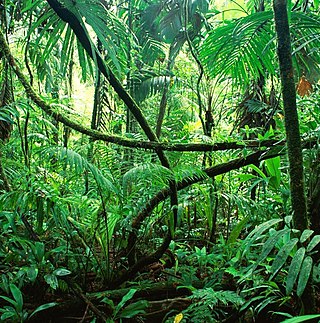
Rainforests are forests characterized by a closed and continuous tree canopy, moisture-dependent vegetation, the presence of epiphytes and lianas and the absence of wildfire. Rainforests can be generally classified as tropical rainforests or temperate rainforests, but other types have been described.

An epiphyte is a plant or plant-like organism that grows on the surface of another plant and derives its moisture and nutrients from the air, rain, water or from debris accumulating around it. The plants on which epiphytes grow are called phorophytes. Epiphytes take part in nutrient cycles and add to both the diversity and biomass of the ecosystem in which they occur, like any other organism. They are an important source of food for many species. Typically, the older parts of a plant will have more epiphytes growing on them. Epiphytes differ from parasites in that they grow on other plants for physical support and do not necessarily affect the host negatively. An organism that grows on another organism that is not a plant may be called an epibiont. Epiphytes are usually found in the temperate zone or in the tropics. Epiphyte species make good houseplants due to their minimal water and soil requirements. Epiphytes provide a rich and diverse habitat for other organisms including animals, fungi, bacteria, and myxomycetes.
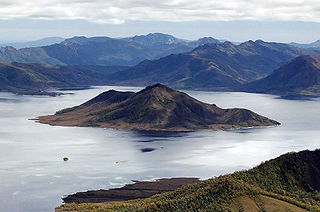
The Tasmanian temperate rain forests are a temperate broadleaf and mixed forests ecoregion in western Tasmania. The ecoregion is part of the Australasian realm, which includes Tasmania and Australia, New Zealand, New Guinea, New Caledonia, and adjacent islands.

Tropical rainforests are dense and warm rainforests with high rainfall typically found between 10 degrees north and south of the equator. They are a subset of the tropical forest biome that occurs roughly within the 28-degree latitudes. Tropical rainforests are a type of tropical moist broadleaf forest, that includes the more extensive seasonal tropical forests. True rainforests usually occur in tropical rainforest climates where there is no dry season – all months have an average precipitation of at least 60 mm. Seasonal tropical forests with tropical monsoon or savanna climates are sometimes included in the broader definition.

An old-growth forest is a forest that has developed over a long period of time without disturbance. Due to this, old-growth forests exhibit unique ecological features. The Food and Agriculture Organization of the United Nations defines primary forests as naturally regenerated forests of native tree species where there are no clearly visible indications of human activity and the ecological processes are not significantly disturbed. One-third of the world's forests are primary forests. Old-growth features include diverse tree-related structures that provide diverse wildlife habitats that increases the biodiversity of the forested ecosystem. Virgin or first-growth forests are old-growth forests that have never been logged. The concept of diverse tree structure includes multi-layered canopies and canopy gaps, greatly varying tree heights and diameters, and diverse tree species and classes and sizes of woody debris.
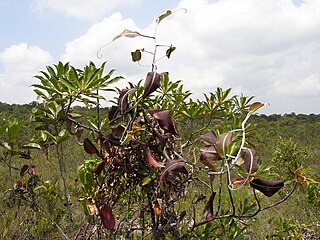
The Sundaland heath forests, also known as Kerangas forest, is a type of tropical moist forest found on the island of Borneo, which is divided between Brunei, Indonesia, and Malaysia, as well as on the Indonesian islands of Belitung and Bangka, which lie to the west of Borneo.
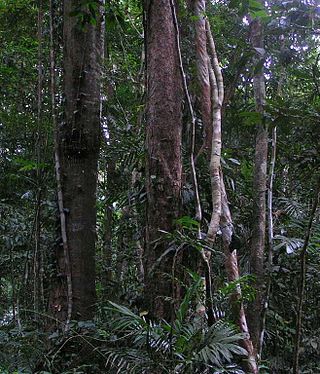
Forest ecology is the scientific study of the interrelated patterns, processes, flora, fauna and ecosystems in forests. The management of forests is known as forestry, silviculture, and forest management. A forest ecosystem is a natural woodland unit consisting of all plants, animals, and micro-organisms in that area functioning together with all of the non-living physical (abiotic) factors of the environment.

In biology, the canopy is the aboveground portion of a plant cropping or crop, formed by the collection of individual plant crowns. In forest ecology, canopy refers to the upper layer or habitat zone, formed by mature tree crowns and including other biological organisms. The communities that inhabit the canopy layer are thought to be involved in maintaining forest diversity, resilience, and functioning. Shade trees normally have a dense canopy that blocks light from lower growing plants.

Myrmecodia is a genus of epiphytic myrmecophytes, native to Southeast Asia and present in Indochina, Malaysia, the Southwest Pacific, the Philippines, and extending south to Fiji and Cape York in Queensland, Australia. It is one of five ant-plant genera in the family Rubiaceae, the others being Anthorrhiza, Hydnophytum, Myrmephytum, and Squamellaria.

Nalini Nadkarni (1954) is an American forest ecologist who pioneered the study of Costa Rican rain forest canopies. Using mountain climbing equipment to make her ascent, Nadkarni first took an inventory of the canopy in 1981, followed by two more inventories in 1984. She is also known with a characteristic nickname, «the queen of the forest canopy».

A hemiepiphyte is a plant that spends part of its life cycle as an epiphyte. The seeds of primary hemiepiphytes germinate in the canopy and initially live epiphytically. They send roots downward, and these roots eventually make contact with the ground. Secondary hemiepiphytes are root-climbers that begin as rooted vines growing upward from the forest floor, but later break their connection to the ground. When this happens, they may send down long roots to the ground.

The forest floor, also called detritus or duff, is the part of a forest ecosystem that mediates between the living, aboveground portion of the forest and the mineral soil, principally composed of dead and decaying plant matter such as rotting wood and shed leaves. In some countries, like Canada, forest floor refers to L, F and H organic horizons. It hosts a wide variety of decomposers and predators, including invertebrates, fungi, algae, bacteria, and archaea.
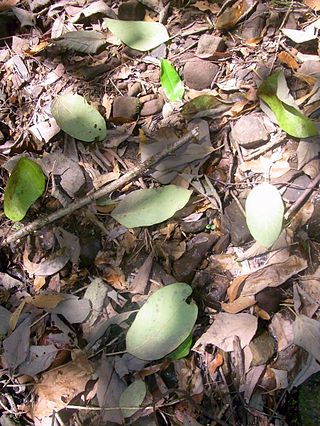
Plant litter is dead plant material that have fallen to the ground. This detritus or dead organic material and its constituent nutrients are added to the top layer of soil, commonly known as the litter layer or O horizon. Litter is an important factor in ecosystem dynamics, as it is indicative of ecological productivity and may be useful in predicting regional nutrient cycling and soil fertility.

Igapó is a word used in Brazil for blackwater-flooded forests in the Amazon biome. These forests and similar swamp forests are seasonally inundated with freshwater. They typically occur along the lower reaches of rivers and around freshwater lakes. Freshwater swamp forests are found in a range of climate zones, from boreal through temperate and subtropical to tropical. In the Amazon Basin of Brazil, a seasonally whitewater-flooded forest is known as a várzea, which is similar to igapó in many regards; the key difference between the two habitats is in the type of water that floods the forest.
Monodominance is an ecological condition in which more than 60% of the tree canopy comprises a single species of tree. Monodominant forests are quite common under conditions of extra-tropical climate types. Although monodominance is studied across different regions, most research focuses on the many prominent species in tropical forests. Connel and Lowman, originally called it single-dominance. Conventional explanations of biodiversity in tropical forests in the decades prior to Connel and Lowman's work either ignored monodominance entirely or predicted that it would not exist.
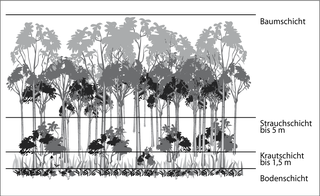
Stratification in the field of ecology refers to the vertical layering of a habitat; the arrangement of vegetation in layers. It classifies the layers of vegetation largely according to the different heights to which their plants grow. The individual layers are inhabited by different animal and plant communities (stratozones).
A canopy root, also known as an arboreal root, is a type of root that grows out of a tree branch underneath an epiphytic mat. These adventitious roots form in response to moist, dark, nutrient-rich conditions that are found in “canopy soils”. Canopy roots have been found in species of maple, poplar, alder, myrtle, beech, and spruce, among many others. They are structurally similar to roots found on the forest floor and likely serve a similar purpose for water and nutrient uptake, though their specific functions are still being studied.
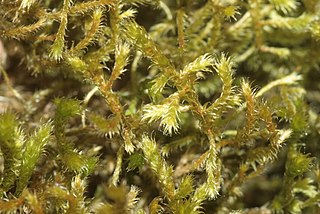
Antitrichia curtipendula is a species of feather-moss found predominantly in western North America and the western coast of Europe.
An ant garden is a mutualistic interaction between certain species of arboreal ants and various epiphytic plants. It is a structure made in the tree canopy by the ants that is filled with debris and other organic matter in which epiphytes grow. The ants benefit from this arrangement by having a stable framework on which to build their nest while the plants benefit by obtaining nutrients from the soil and from the moisture retained there.
Saprotrophic bacteria are bacteria that are typically soil-dwelling and utilize saprotrophic nutrition as their primary energy source. They are often associated with soil fungi that also use saprotrophic nutrition and both are classified as saprotrophs.
References
- ↑ Tejo Haristoy, Camila; Zabowski, Darlene; Nadkarni, Nalini (May 30, 2014). "Canopy Soils of Sitka Spruce and Bigleaf Maple in the Queets River Watershed, Washington". Soil Science Society of America Journal. 78 (S1): 118–124. Bibcode:2014SSASJ..78S.118H. doi:10.2136/sssaj2013.07.0300nafsc.
- ↑ Nadkarni, Nalini (1984). "Biomass and mineral capital of epiphytes in an Acer macrophyllum community of a temperate moist coniferous forest, Olympic Peninsula, Washington State". Canadian Journal of Botany. 62 (11): 2223–2228. doi:10.1139/b84-302.
- ↑ "Search | Soil Science Society of America".
- ↑ Dangerfield, Cody R.; Nadkarni, Nalini M.; Brazelton, William (September 6, 2017). "Canopy soil bacterial communities altered by severing host tree limbs". PeerJ. 5: e3773. doi: 10.7717/peerj.3773 . PMC 5591635 . PMID 28894646.
- ↑ Hoeber, Vincent; Weichgrebe, Tizian; Zotz, Gerhard (June 1, 2019). "Accidental epiphytism in the Harz Mountains, Central Europe". Journal of Vegetation Science. 30 (4): 765–775. Bibcode:2019JVegS..30..765H. doi:10.1111/jvs.12776. S2CID 191192192.
- ↑ Zotz, Gerhard (March 15, 2004). "Vascular epiphytes in the temperate zones–a review" (PDF). Plant Ecology. 176 (2): 173–183. doi:10.1007/s11258-004-0066-5. S2CID 38353313.
- ↑ Clark, Peter U.; Dyke, Arthur S.; Shakun, Jeremy D.; Carlson, Anders E.; Clark, Jorie; Wohlfarth, Barbara; Mitrovica, Jerry X.; Hostetler, Steven W.; McCabe, A. Marshall (2009). "The Last Glacial Maximum". Science. 325 (5941): 710–714. Bibcode:2009Sci...325..710C. doi:10.1126/science.1172873. PMID 19661421. S2CID 1324559. Archived from the original on 2019-12-09. Retrieved 2019-12-05.
- ↑ Ortega-Solísac, Gabriel; Diaz, Ivan; Mellado-Mansilla, Daniela; Telloc, Francisco; Moreno, Ricardo; Tejo, Camila (September 15, 2017). "Ecosystem engineering by Fascicularia bicolor in the canopy of the South-American temperate rainforest". Forest Ecology and Management. 400: 417–428. Bibcode:2017ForEM.400..417O. doi:10.1016/j.foreco.2017.06.020.